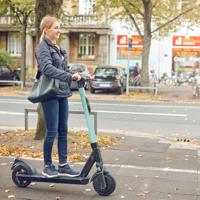Electric scooters have become increasingly popular as a convenient and eco-friendly mode of transportation. As urban centers continue to grow and evolve, the need for practical and sustainable personal transport solutions becomes more pressing. Electric scooters offer a viable alternative to traditional commuting options, providing efficiency, flexibility, and the enjoyable benefit of a small carbon footprint.
In this guide, we'll explore various aspects of electric scooters to help you understand what they are, how they work, and what you might look for when considering a purchase.
What Are Electric Scooters?
Electric scooters, often referred to simply as "e-scooters", are two-wheeled vehicles powered by an electric motor. They are akin to traditional scooters but equipped with rechargeable batteries and electronic controls. Typically, users stand on a platform and hold onto handlebars, using acceleration and braking controls similar to those of a bicycle or motorcycle.
Thanks to their compact size, electric scooters are an ideal fit for urban lifestyles, providing a means to cover short distances without the need for a car or public transport.
Types of Electric Scooters
There are various types of electric scooters available on the market, catering to different needs and preferences. Some of the common types include:
Commuter Scooters: These are designed for daily use and are often lightweight and foldable for easy storage. Examples include the Xiaomi Mi Electric Scooter, known for its portability and affordability.
Performance Scooters: Built for speed and range, these scooters offer higher power output and are often more robust to handle higher speeds. The Dualtron Thunder is a go-to model for those seeking durability and performance.
Off-road Scooters: For those who enjoy venturing beyond smooth pavements, off-road scooters come with enhanced suspension systems and all-terrain tires. The Kaabo Wolf Warrior is an example that stands out in this category.
Sharing Scooters: These scooters are commonly found in urban rental programs, operated by companies such as Lime and Bird. They tend to be durable and secure, designed for public use.
How Do Electric Scooters Work?
Electric scooters run on electric motors powered by rechargeable batteries. Users control speed through a throttle mechanism, typically found on the handlebar, and braking through either electronic or mechanical systems.
The battery life and motor power can significantly affect performance, with variables such as top speed, range, and acceleration differing from model to model. Charging times and the lifespan of the battery are additional considerations that potential users often evaluate.
Key Considerations When Choosing an Electric Scooter
Choosing the right electric scooter involves deliberating over several factors. Here are a few essential considerations:
Range: Consider the distance you'll likely travel on a regular journey. Battery capacity and energy efficiency directly impact the range. For more information on choosing the right vehicle for your needs, see our guide on Electric Bikes and Scooters.
Weight and Portability: For those who commute partially by public transportation, weight and portability are vital. A foldable, lightweight design, such as a folding electric bike, might be more suitable.
Speed: Evaluate how fast you need to travel. Most models offer speeds between 15-30 mph, but ensure local regulations are observed.
Build Quality: The frame, wheels, and suspension play a role in overall experience and safety. Look for quality construction and materials for durability.
Price: Electric scooters vary widely in price. Weigh your needs against your budget to find a workable compromise.
Legal Considerations
It's essential to familiarize yourself with your local laws and regulations about electric scooters. These rules can cover aspects such as speed limits, helmet requirements, and where scooters may be legally used (such as on roads or sidewalks).
In many regions, policymakers are continually updating regulations in response to the rising popularity of electric scooters, aiming to ensure the safety and integration of this technology in urban transport networks.
Final Thoughts
Electric scooters present a unique and flexible transport solution that fits effortlessly into a smart lifestyle. As urban infrastructure continues to evolve alongside technological advancements, these compact devices are likely to play a crucial role in shaping future public and private transportation dynamics.
When deciding to invest in an electric scooter, take the time to assess your needs against the features offered by various models. Try different types if possible, and prioritize safety alongside convenience. This is a personal journey that could significantly enhance your commuting experience.
Ultimately, electric scooters are an exciting and practical extension of today's smart lifestyle, blending technology and mobility in a way that's both modern and mindful of our environmental footprint.




